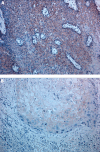Expression of cell adhesion molecules in oesophageal carcinoma and its prognostic value
- PMID: 15790695
- PMCID: PMC1770622
- DOI: 10.1136/jcp.2004.018036
Expression of cell adhesion molecules in oesophageal carcinoma and its prognostic value
Abstract
Oesophageal carcinoma remains a disease of poor prognosis. Surgical cure rates are compromised by the fact that most patients are diagnosed at a late stage of disease because of the delayed onset of symptoms, by which time metastases and organ infiltration may have already occurred. Thus, invasion and metastases play a key role in influencing patient survival, and the search for novel treatments may therefore hinge on gaining insight into the mechanisms controlling these processes. It has been established that the initial step in the metastatic cascade is the detachment of tumour cells from the primary tumour via dysregulation of normal cell-cell and cell-matrix interactions. Distinct proteins known as cell adhesion molecules (CAMs) mediate these interactions. In recent years, a plethora of information has contributed to the in depth understanding of these molecules. This review provides a brief description of five families of CAMs (cadherins, integrins, CD44, immunoglobulin superfamily, and selectins) and highlights their altered expression in relation both to prognosis and tumour behaviour in squamous cell carcinoma and adenocarcinoma of the oesophagus.
Figures


References
-
- Lerut T, Coosemans W, De Leyn P, et al. Treatment of esophageal carcinoma. Chest 1999;116:463S–5S. - PubMed
-
- Klimstra DS. Pathologic prognostic factors in esophageal carcinoma. Semin Oncol 1994;21:425–30. - PubMed
-
- Edelman GM, Crossin KL. Cell adhesion molecules: implications for a molecular histology. Annu Rev Biochem 1991;60:155–90. - PubMed
-
- Nicolson GL. Cancer metastasis: tumor cell and host organ properties important in metastasis to specific secondary sites. Biochim Biophys Acta 1988;948:175–224. - PubMed
-
- Liotta LA. Tumour invasion and metastasis: role of the extracellular matrix. Cancer Res 1986;46:1–7. - PubMed
Publication types
MeSH terms
Substances
LinkOut - more resources
Full Text Sources
Medical
Miscellaneous
